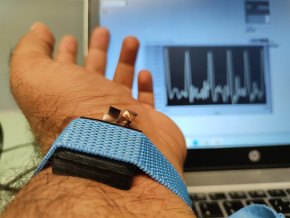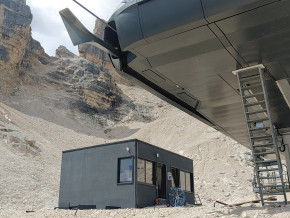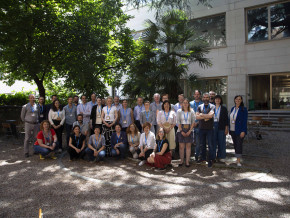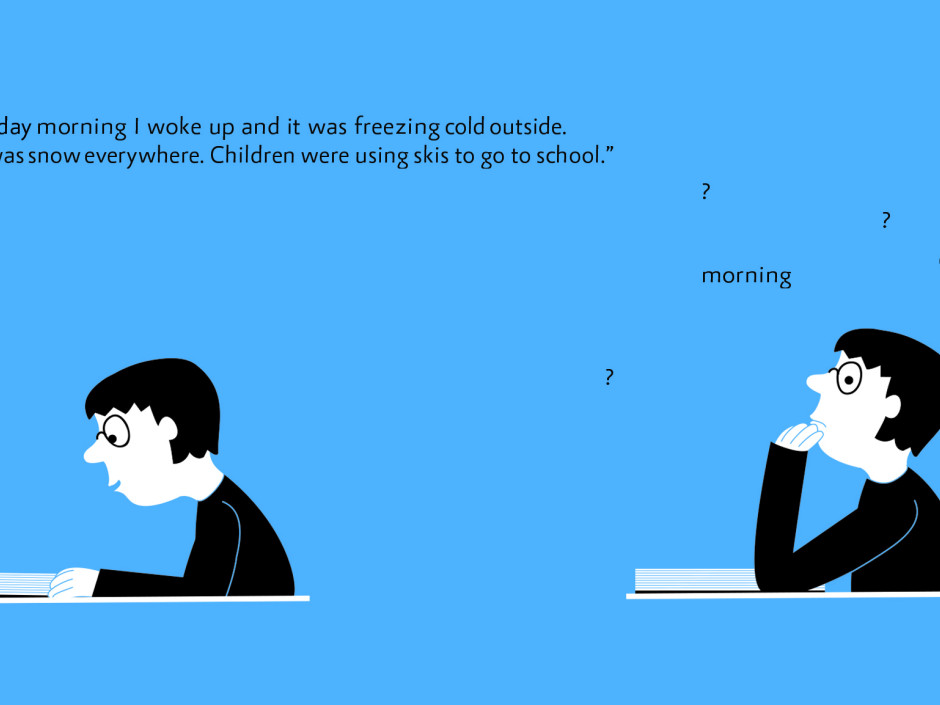Reading with Reason
Artificial intelligence is at the heart of TERENCE, an Adaptive Learning System able to tailor reading games for children with the poor comprehension. The technology, co-developed by unibz’s Faculty of Computer Science, can help educators transform the potential of young lives.
Eight-year-old Walter flips opens the book on his school desk and, diligently following his teacher’s instructions, reads the text on page three out loud: “Yesterday morning I woke up and it was freezing cold outside. There was snow everywhere. Children were using skis to go to school.” He reads effortlessly and with perfect pronunciation. The teacher reflects, then asks him, “So what season is it, Walter?” The boy blushes and bows his head: he cannot answer.
Walter is a ‘poor comprehender’. Although he’s just a fictional character here, children like Walter struggle to find meaning from a text. They can have problems accessing the information to remember a text or trouble filling in the gaps for information that may be missing. To help these children there’s TERENCE, an innovative educational tool developed by an international consortium, including unibz’s Department of Computer Science. TERENCE uses the entertaining interface of video games—supercharged with some sophisticated AI technology—to help educators to improve the comprehension skills of struggling students.
A ‘Challenging’ Condition
Poor comprehenders are usually diagnosed around the age of eight, when teachers start to notice that they read well, but do not understand the text. Some reports indicate that the number of poor comprehenders has risen over the years: 5 to 10% of Italian children between seven and eleven years old are now considered to have reading comprehension difficulties. Professor of Cognitive Psychology at the University of Pavia, Paola Palladino has been studying the condition for 15 years.
“There are not a lot of papers on this condition. Studies are showing it’s not linked specifically to IQ, and although poor vocabulary has been a suspect, it is more likely to be the result of poor comprehension than the cause. And, unlike dyslexia, they have good word decoding skills.” Research has illustrated some of the mechanisms of poor comprehension, for example, poor meta-cognitive processes (used for things like developing and using the right strategies), difficulty to eliminate irrelevant information, or an inability to retain concepts in working memory. Psychologists conjecture that the underlying causes are biological and environmental— truth is, no one really knows why.
The long-term educational and psychosocial effects of poor comprehension for children are serious. When a kid can’t retrieve the right meaning from a text, their study skills are handcuffed: it makes learning any subject painful at best. Repeated failure reduces self-esteem, and the social stigma of slow learning makes them victims of exclusion by their peers. All these effects can follow students throughout their schooling.
In a 1995 study, Palladino and colleagues analysed the educational future of learners with poor comprehension. “We discovered that they mainly drop out after compulsory education,” Palladino says. “They prefer not to continue with this challenging condition.”
The First—and Fun—Targeted Learning System
This is why TERENCE was developed. The three-year European FP7 project, which involves partners from eight European countries, sought to design and develop the first Adaptive Learning System (ALS) for poor comprehenders, including hearing- impaired and deaf children, as well as for their educators. Produced in Italian and English, the project, under the scientific and technological coordination of unibz’s Faculty of Computer Science, engages children in a video game environment that captures their attention while exercising their reading skills.
All in all, researchers studied and “played” with over 500 children in the UK and Italy in order to design the kinds of games that will engage children to reason about stories.
Designing the system required an extensive study with domain experts, teachers and learners to understand the strategies in the laboratory and in the classroom that were producing effective results. All in all, researchers studied and “played” with over 500 children in the UK and Italy in order to design the kinds of games that will engage children to reason about stories.
Under the Hood
The versatility of TERENCE is in its 156 stories, for silent, individual reading and as well as for reading games. Divided into four difficulty levels, with 12 games per story, that’s a whopping 1872 potential games over various skill levels.
“The challenge for us as researchers,” says Rosella Gennari, one of the principal researchers on the AI side of TERENCE, “is that we had to automate the development of these smart games by adapting or creating existing AI technologies to cater to the real needs of children. In the pursuit of this, we had to balance our goals of researchers in seeking to generalise our work for the scientific community, and the goal of therapists who seek effective interventions.”
Gennari, the scientific and technological coordinator of the project, is a researcher at unibz’s Faculty of Computer Science. She has a keen interest in human-centered computing, and a long-standing expertise in AI. Along with colleagues at the University of Aquila, led by Pier Paolo Vittorini, she spent three years developing the mix of technologies that forms the heart of the game.
“TERENCE uses three levels of technology,” Gennari explains. The first involves a story module that uses a Natural Language Processor (NLP) and a Constraint-based Reasoner (CR) to ‘meta-tag’ any story’s events as well as their temporal or causal relations, producing annotated stories. Then using the same technology, a game generation module generates the textual components, and ranks, selects, and decides the number of games available per difficulty level.
“The constraint-based reasoner processes the text and deduces information necessary for generating games of different complexity,” continues Gennari. “For example, a poor comprehender may have difficulty ordering three events in temporal sequence that are implicit and ‘hidden’ in a text like: ‘John picks up the ball. The ball is thrown into the yard. […] The ball is bouncing in the yard.’ The constraint-based reasoner generates games for the child with different degrees of complexity to help him understand that John picked up the ball and then the ball bounces in the yard.”
After the generation of the game components, everything is neatly packaged for the user into images and text, in a quiz-like format, by a third, visualisation module, which produces the screen image that the children actually see, according to his or her reading profile, age and gender.
“According to how fast children read stories and their performance, the system is going to infer ‘OK, you are getting quite good at resolving such stories, so lets move on to the next level of difficulty,’ in a manner that is transparent to the child,” Gennari says.
Terrence V2
Results from the Italian trials of TERENCE were encouraging. In a town in the centre of Italy, with a group of young readers in which 21% were poor comprehenders, the system was able to drop that percentage to 9%. In another town in Italy, the prevalence dropped from 6% to less than 1%. Meanwhile, a group not using the system showed no significant change.
Based on these results, the researchers have a right to be optimistic about the future of their creation. The UK and Italian partners demonstrated the software at numerous schools around the two countries. The consortium is now receiving concrete interest from public and private groups for commercialising the product.
“At the moment, TERENCE can be used by schools, but it’s still just a research prototype— it’s not perfect,” Gennari explains. “It will take an industrial company to make it something that can be sold and used every day by everyone. Given its success as therapy tool after evaluations in the field, we are optimistic about its future.”
Related Articles

Tecno-prodotti. Creati nuovi sensori triboelettrici nel laboratorio di sensoristica al NOI Techpark
I wearable sono dispositivi ormai imprescindibili nel settore sanitario e sportivo: un mercato in crescita a livello globale che ha bisogno di fonti di energia alternative e sensori affidabili, economici e sostenibili. Il laboratorio Sensing Technologies Lab della Libera Università di Bolzano (unibz) al Parco Tecnologico NOI Techpark ha realizzato un prototipo di dispositivo indossabile autoalimentato che soddisfa tutti questi requisiti. Un progetto nato grazie alla collaborazione con il Center for Sensing Solutions di Eurac Research e l’Advanced Technology Institute dell’Università del Surrey.

unibz forscht an technologischen Lösungen zur Erhaltung des Permafrostes in den Dolomiten
Wie kann brüchig gewordener Boden in den Dolomiten gekühlt und damit gesichert werden? Am Samstag, den 9. September fand in Cortina d'Ampezzo an der Bergstation der Sesselbahn Pian Ra Valles Bus Tofana die Präsentation des Projekts „Rescue Permafrost " statt. Ein Projekt, das in Zusammenarbeit mit Fachleuten für nachhaltiges Design, darunter einem Forschungsteam für Umweltphysik der unibz, entwickelt wurde. Das gemeinsame Ziel: das gefährliche Auftauen des Permafrosts zu verhindern, ein Phänomen, das aufgrund des globalen Klimawandels immer öfter auftritt. Die Freie Universität Bozen hat nun im Rahmen des Forschungsprojekts eine erste dynamische Analyse der Auswirkungen einer technologischen Lösung zur Kühlung der Bodentemperatur durchgeführt.

Gesunde Böden dank Partizipation der Bevölkerung: unibz koordiniert Citizen-Science-Projekt ECHO
Die Citizen-Science-Initiative „ECHO - Engaging Citizens in soil science: the road to Healthier Soils" zielt darauf ab, das Wissen und das Bewusstsein der EU-Bürger:innen für die Bodengesundheit über deren aktive Einbeziehung in das Projekt zu verbessern. Mit 16 Teilnehmern aus ganz Europa - 10 führenden Universitäten und Forschungszentren, 4 KMU und 2 Stiftungen - wird ECHO 16.500 Standorte in verschiedenen klimatischen und biogeografischen Regionen bewerten, um seine ehrgeizigen Ziele zu erreichen.

Erstversorgung: Drohnen machen den Unterschied
Die Ergebnisse einer Studie von Eurac Research und der Bergrettung Südtirol liegen vor.
